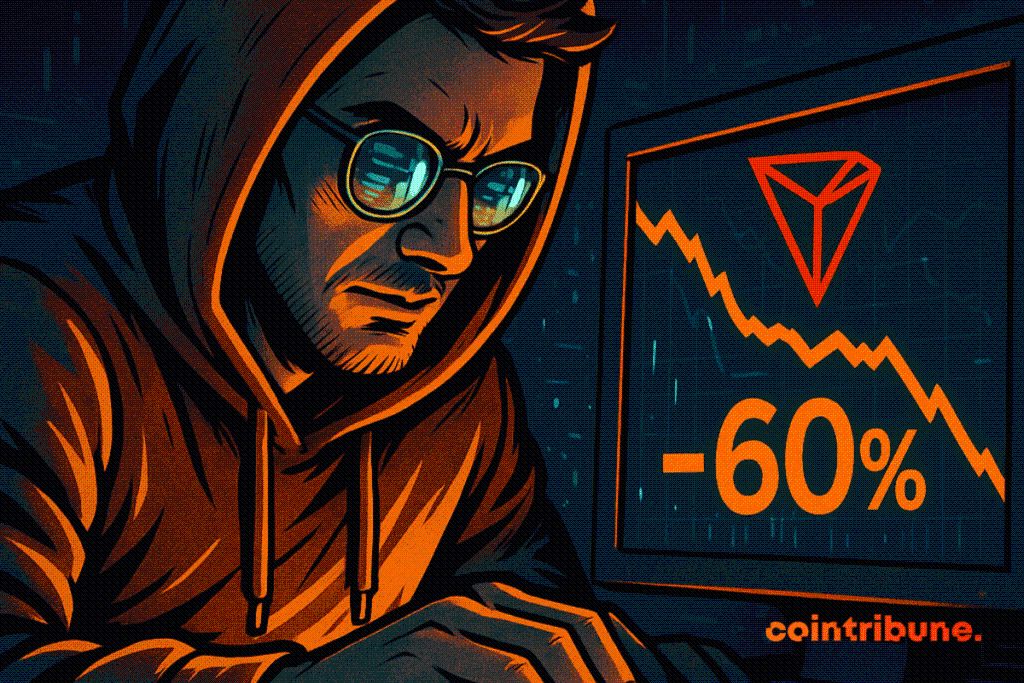Crypto: Tron Reduces Its Fees by 60%
Tron has just announced a landmark measure: a 60% reduction in its network fees. This decision was validated by a community vote and confirmed by Justin Sun. It aims to make transactions on its network more accessible after a period when costs had significantly increased.

In brief
- Tron voted for a 60% reduction in its network fees, making its transactions much more accessible.
- This decision mainly benefits stablecoin users, a sector where Tron already holds nearly 30% of the global market.
- In the long term, the network hopes to offset the revenue drop by a massive increase in volumes and strengthen its position against Ethereum.
Tron, between regained attractiveness and bold strategy
Tron, which will be soon available on the MetaMask wallet , has long been recognized as a low-cost blockchain ideal for fast and frequent transfers. However, over the past few months, fees had jumped, sometimes reaching $2.50 per transaction.
This level began to drive away some users. As a result, Tron chose to reduce costs. It thus seeks to restore its image and consolidate its position as a leader in crypto payments.
This decision does not come out of nowhere. It results from a community vote, and Justin Sun, founder of Tron, confirmed it. By aligning with a community strategy, the network shows it is betting on decentralized governance to shape its future. In the short term, this may reduce revenue from fees, but in the long term, the multiplication of transactions could more than compensate for this loss.
In short, Tron is betting on volume effect rather than margin effect: a logic very close to that of exchange platforms that lower their commissions to attract more and more users.
The impact for users and the stablecoin ecosystem
The first beneficiaries of this massive fee reduction are obviously regular users. These are particularly those who rely on Tron to transfer stablecoins. With over $82 billion of stablecoins circulating on its network, Tron holds nearly 30% of the global market. Ethereum comes just behind. It is a major strategic strength in decentralized finance.
Stablecoins, such as USDT and USDC, allow navigating the crypto universe without suffering from the extreme volatility of bitcoin or ether. The fact that Tron makes their transfers even cheaper could strengthen its attractiveness compared to Ethereum and Solana. However, on these blockchains, fees sometimes remain high.
For a user, sending stablecoins at a lower cost is a tangible saving. But also, it is an incentive to multiply operations: arbitrage, lending, cross-border payments… These are use cases that could explode thanks to this decrease.
The fee reduction on Tron is not just a marketing gesture. It is part of a real market share war. Ethereum remains dominant with nearly $150 billion in stablecoins, but its gas fees still deter some users.
Solana, on its side, attracts for its speed but suffered from several technical outages. If this strategy succeeds, the capitalization of TRX, already close to $32 billion, could benefit from this influx of activity.
Disclaimer: The content of this article solely reflects the author's opinion and does not represent the platform in any capacity. This article is not intended to serve as a reference for making investment decisions.
You may also like
$8.8 billion outflow countdown: MSTR is becoming the abandoned child of global index funds
The final result will be revealed on January 15, 2026, and the market has already started to vote with its feet.

Deconstructing DAT: Beyond mNAV, How to Identify "Real vs. Fake HODLing"?
There is only one iron rule for investing in DAT: ignore premium bubbles and only invest in those with a genuine flywheel of continuously increasing "crypto per share."

Empowered by AI Avatars, How Does TwinX Create Immersive Interaction and a Value Closed Loop?
1. **Challenges in the Creator Economy**: Web2 content platforms suffer from issues such as opaque algorithms, non-transparent distribution, unclear commission rates, and high costs for fan migration, making it difficult for creators to control their own data and earnings. 2. **Integration of AI and Web3**: The development of AI technology, especially AI Avatar technology, combined with Web3's exploration of the creator economy, offers new solutions aimed at breaking the control of centralized platforms and reconstructing content production and value distribution. 3. **Positioning of the TwinX Platform**: TwinX is an AI-driven Web3 short video social platform that aims to reconstruct content, interaction, and value distribution through AI avatars, immersive interactions, and a decentralized value system, enabling creators to own their data and income. 4. **Core Features of TwinX**: These include AI avatar technology, which allows creators to generate a learnable, configurable, and sustainably operable "second persona", as well as a closed-loop commercialization pathway that integrates content creation, interaction, and monetization. 5. **Web3 Characteristics**: TwinX embodies the assetization and co-governance features of Web3. It utilizes blockchain to confirm and record interactive behaviors, turning user activities into traceable assets, and enables participants to engage in platform governance through tokens, thus integrating the creator economy with community governance.

Aster CEO explains in detail the vision of Aster privacy L1 chain, reshaping the decentralized trading experience
Aster is set to launch a privacy-focused Layer 1 (L1) public chain, along with detailed plans for token empowerment, global market expansion, and liquidity strategies.

